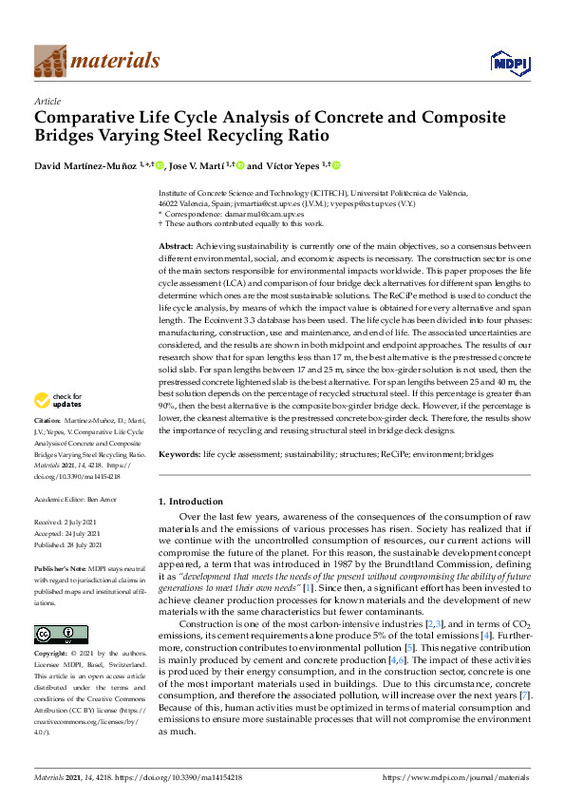JavaScript is disabled for your browser. Some features of this site may not work without it.
Buscar en RiuNet
Listar
Mi cuenta
Estadísticas
Ayuda RiuNet
Admin. UPV
Comparative Life Cycle Analysis of Concrete and Composite Bridges Varying Steel Recycling Ratio
Mostrar el registro sencillo del ítem
Ficheros en el ítem
| dc.contributor.author | Martínez-Muñoz, D.
|
es_ES |
| dc.contributor.author | Martí Albiñana, José Vicente
|
es_ES |
| dc.contributor.author | Yepes, V.
|
es_ES |
| dc.date.accessioned | 2021-11-05T14:06:54Z | |
| dc.date.available | 2021-11-05T14:06:54Z | |
| dc.date.issued | 2021-08 | es_ES |
| dc.identifier.uri | http://hdl.handle.net/10251/176261 | |
| dc.description.abstract | [EN] Achieving sustainability is currently one of the main objectives, so a consensus between different environmental, social, and economic aspects is necessary. The construction sector is one of the main sectors responsible for environmental impacts worldwide. This paper proposes the life cycle assessment (LCA) and comparison of four bridge deck alternatives for different span lengths to determine which ones are the most sustainable solutions. The ReCiPe method is used to conduct the life cycle analysis, by means of which the impact value is obtained for every alternative and span length. The Ecoinvent 3.3 database has been used. The life cycle has been divided into four phases: manufacturing, construction, use and maintenance, and end of life. The associated uncertainties are considered, and the results are shown in both midpoint and endpoint approaches. The results of our research show that for span lengths less than 17 m, the best alternative is the prestressed concrete solid slab. For span lengths between 17 and 25 m, since the box-girder solution is not used, then the prestressed concrete lightened slab is the best alternative. For span lengths between 25 and 40 m, the best solution depends on the percentage of recycled structural steel. If this percentage is greater than 90%, then the best alternative is the composite box-girder bridge deck. However, if the percentage is lower, the cleanest alternative is the prestressed concrete box-girder deck. Therefore, the results show the importance of recycling and reusing structural steel in bridge deck designs. | es_ES |
| dc.description.sponsorship | This research was funded by Spanish Ministry of Economy and Business (Project: BIA201785098-R), the Spanish Ministry of Science and Innovation (Project: PID2020-117056RB-I00), along with FEDER funding and Spanish Ministry of Science, Innovation and Universities for David MartinezMunoz's University Teacher Training Grant (FPU-18/01592). | es_ES |
| dc.language | Inglés | es_ES |
| dc.publisher | MDPI AG | es_ES |
| dc.relation.ispartof | Materials | es_ES |
| dc.rights | Reconocimiento (by) | es_ES |
| dc.subject | Life cycle assessment | es_ES |
| dc.subject | Sustainability | es_ES |
| dc.subject | Structures | es_ES |
| dc.subject | ReCiPe | es_ES |
| dc.subject | Environment | es_ES |
| dc.subject | Bridges | es_ES |
| dc.subject.classification | INGENIERIA DE LA CONSTRUCCION | es_ES |
| dc.title | Comparative Life Cycle Analysis of Concrete and Composite Bridges Varying Steel Recycling Ratio | es_ES |
| dc.type | Artículo | es_ES |
| dc.identifier.doi | 10.3390/ma14154218 | es_ES |
| dc.relation.projectID | info:eu-repo/grantAgreement/AEI/Plan Estatal de Investigación Científica y Técnica y de Innovación 2013-2016/BIA2017-85098-R/ES/DISEÑO Y MANTENIMIENTO OPTIMO ROBUSTO Y BASADO EN FIABILIDAD DE PUENTES E INFRAESTRUCTURAS VIARIAS DE ALTA EFICIENCIA SOCIAL Y MEDIOAMBIENTAL BAJO PRESUPUESTOS RESTRICTIVOS/ | es_ES |
| dc.relation.projectID | info:eu-repo/grantAgreement/MCIU//FPU18%2F01592//AYUDA PREDOCTORAL FPU-MARTINEZ MUÑOZ/ | es_ES |
| dc.relation.projectID | info:eu-repo/grantAgreement/AGENCIA ESTATAL DE INVESTIGACION//PID2020-117056RB-I00//OPTIMIZACION HIBRIDA DEL CICLO DE VIDA DE PUENTES Y ESTRUCTURAS MIXTAS Y MODULARES DE ALTA EFICIENCIA SOCIAL Y MEDIOAMBIENTAL BAJO PRESUPUESTOS RESTRICTIVOS / | es_ES |
| dc.rights.accessRights | Abierto | es_ES |
| dc.contributor.affiliation | Universitat Politècnica de València. Departamento de Ingeniería de la Construcción y de Proyectos de Ingeniería Civil - Departament d'Enginyeria de la Construcció i de Projectes d'Enginyeria Civil | es_ES |
| dc.description.bibliographicCitation | Martínez-Muñoz, D.; Martí Albiñana, JV.; Yepes, V. (2021). Comparative Life Cycle Analysis of Concrete and Composite Bridges Varying Steel Recycling Ratio. Materials. 14(15):1-22. https://doi.org/10.3390/ma14154218 | es_ES |
| dc.description.accrualMethod | S | es_ES |
| dc.relation.publisherversion | https://doi.org/10.3390/ma14154218 | es_ES |
| dc.description.upvformatpinicio | 1 | es_ES |
| dc.description.upvformatpfin | 22 | es_ES |
| dc.type.version | info:eu-repo/semantics/publishedVersion | es_ES |
| dc.description.volume | 14 | es_ES |
| dc.description.issue | 15 | es_ES |
| dc.identifier.eissn | 1996-1944 | es_ES |
| dc.identifier.pmid | 34361411 | es_ES |
| dc.identifier.pmcid | PMC8347549 | es_ES |
| dc.relation.pasarela | S\444773 | es_ES |
| dc.contributor.funder | AGENCIA ESTATAL DE INVESTIGACION | es_ES |
| dc.contributor.funder | European Regional Development Fund | es_ES |
| dc.contributor.funder | Ministerio de Ciencia, Innovación y Universidades | es_ES |
| dc.subject.ods | 09.- Desarrollar infraestructuras resilientes, promover la industrialización inclusiva y sostenible, y fomentar la innovación | es_ES |
| upv.costeAPC | 2300 | es_ES |








